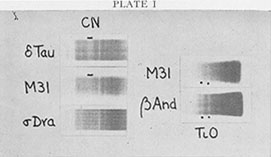


3.1. The Spectrum of the Nuclear Region
Spectrograms were obtained by G. H. Herbig and Morgan in
the autumn of 1955 with the 36-inch Crossley reflector of the Lick
Observatory; the two-prism nebular spectrograph was used, together
with Kodak plates of I-N emulsion, which were hypersensitized
in ammonia. The slit was centered on the nuclear region and
the nucleus was trailed during the exposure to give a uniformly
widened spectrum. A number of exposures of varying duration
were made in order to obtain a record of the whole spectral interval

 3700-8000 with optimum density; the dispersion is 430 Å/mm
at Hy. A series of plates of standard stars in the MK system
also was obtained, under nearly identical spectroscopic conditions.
This material made possible a comparison of the nuclear region
of M 31 with MK standard stars over the full range of
wavelength from the ultraviolet to the infrared.
3700-8000 with optimum density; the dispersion is 430 Å/mm
at Hy. A series of plates of standard stars in the MK system
also was obtained, under nearly identical spectroscopic conditions.
This material made possible a comparison of the nuclear region
of M 31 with MK standard stars over the full range of
wavelength from the ultraviolet to the infrared.
Although the dispersion is very low, certain unique conclusions
may be drawn; these are as follows: (a) The principal
contributors to the luminosity of the inner, brightest region of M 31
in the spectral interval 
 3880-4300 are "cyanogen giants" - that
is, stars in the general category gG8 to gK3. (b) The principal
contributors in the neighborhood of
3880-4300 are "cyanogen giants" - that
is, stars in the general category gG8 to gK3. (b) The principal
contributors in the neighborhood of
 4600 are probably K4 to K5
giants. (c) Bands of TiO are present in the red and infrared
regions. The luminosities of the M-type stars responsible for these
bands have not yet been observationally determined, but it seems
highly probable that they are normal giants. Certain luminosity
criteria described by Öhman
4
should settle this point when
observations with higher dispersion in the red region have been
obtained. (d) In spectral regions below
4600 are probably K4 to K5
giants. (c) Bands of TiO are present in the red and infrared
regions. The luminosities of the M-type stars responsible for these
bands have not yet been observationally determined, but it seems
highly probable that they are normal giants. Certain luminosity
criteria described by Öhman
4
should settle this point when
observations with higher dispersion in the red region have been
obtained. (d) In spectral regions below
 3900 there is evidence for
the presence of an appreciable number of stars of types G0 to G5.
Their presence is suggested by a softening in the contrast of the
K-type absorptions in the ultraviolet. It is very improbable,
however, that a considerable proportion of stars of spectral types
earlier than F8 is present; in particular, no indication of hydrogen
absorption lines in the ultraviolet has been observed. The spectrum
of the inner region of M 31 is illustrated in Plate I.
3900 there is evidence for
the presence of an appreciable number of stars of types G0 to G5.
Their presence is suggested by a softening in the contrast of the
K-type absorptions in the ultraviolet. It is very improbable,
however, that a considerable proportion of stars of spectral types
earlier than F8 is present; in particular, no indication of hydrogen
absorption lines in the ultraviolet has been observed. The spectrum
of the inner region of M 31 is illustrated in Plate I.

|
Plate I. Spectra of the central region of
M 31 and of comparison stars in the
blue (left) and red (right). The MK spectral type of
|